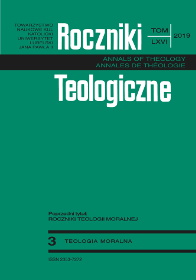Horyzont interpretacyjny tzw. „sytuacji nieregularnych” (Amoris laetitia) w świetle nauczania Jana Pawła II oraz dokumentu Międzynarodowej Komisji Teologicznej pt. Interpretacja dogmatów
Abstrakt
Artykuł poświęcony jest problematyce interpretacji nauczania papieża Franciszka na temat tzw. „sytuacji nieregularnych” zaprezentowanych w adhortacji Amoris laetitia. Jest to problem ważny, ponieważ ta część papieskiej teologii budzi największe kontrowersje. Przyglądając się dynamice rozwoju doktryny Kościoła, można bez trudu dostrzec jej nieustanny rozwój idący w kierunku coraz lepszego wyjaśniania prawd wiary, jak też nieustannej aktualizacji nauczania. Jednakże każda aktualizacja musi być zanurzona w Tradycji, ponieważ prawda pozostaje w swojej istocie niezmienna, a jedynie zmieniać się może pewna forma językowa jej przekazu. Przyjmując hermeneutykę ciągłości, jaka cechuje rozwój doktryny Kościoła, uprawnione jest poszukiwanie właściwego kontekstu hermeneutycznego dla „sytuacji nieregularnych” w świetle teologii i antropologii Jana Pawła II oraz na tle dokumentu Międzynarodowej Komisji Teologicznej poświęconego interpretacji dogmatów.
Bibliografia
Bartnik Cz. S., Dogmatyka katolicka, t. 2, Lublin 2010.
Buttiglione R., Przyjacielska odpowiedź krytykom „Amoris Laetitia”, tłum. M. Chojnacki, Kraków 2018.
Franciszek, Adhortacja „Amoris Laetitia”, Rzym 2016.
Jan Paweł II, Adhortacja „Christifideles laici”, Rzym 1988.
Jan Paweł II, Adhortacja „Ecclesia In Oceania”, Rzym 2001.
Jan Paweł II, Adhortacja „Familiaris consortio”, Rzym 1981.
Jan Paweł II, Adhortacja „Reconciliatio et paenitentia”, Rzym 1984.
Jan Paweł II, Encyklika „Dominum et Vivificantem”, Rzym 1986.
Jan Paweł II, Encyklika „Ecclesia de Eucharistia”, Rzym 2003.
Jan Paweł II, Encyklika „Veritatis splendor”, Rzym 1993.
Jan Paweł II, List do rodzin „Gratissimam sane”, Rzym 1994.
Jan Paweł II, Mężczyzną i niewiastą stworzył ich. Odkupienie ciała a sakramentalność małżeństwa, Lublin 2011.
May W.E., La `communio personarum' e l'atto coniugale, w: Morale Coniugale e Sacramento della Penitenza: Riflessioni sul Vademecum per i Confessori, red. A. Card, L. Trujillo, F.G. Hellin, Roma 1998, s. 135-150.
Międzynarodowa Komisja Teologiczna, Interpretacja dogmatów, Rzym 1988.
Müller G.L., Przedmowa. Dlaczego adhortacja „Amoris Laetitia” może i powinna być rozumiana w sensie ortodoksyjnym, w: R. Buttiglione, Przyjacielska odpowiedź krytykom „Amoris Laetitia”, tłum. M. Chojnacki, Kraków 2018, s. 5-28.
Pokrywka M., Rola Eucharystii w budowaniu małżeńskiej „communio personarum”, RT 52(2005), z. 3, s. 49-60.
Ratzinger J., List do biskupów Kościoła katolickiego na temat przyjmowania Komunii świętej przez wiernych rozwiedzionych żyjących w nowych związkach, Rzym 1994.
Ratzinger J., List do biskupów Kościoła katolickiego o niektórych aspektach Kościoła pojętego jako komunia „Communionis notio”, Rzym 1992.
Sobór Watykański II, Konstytucja duszpasterska o Kościele w świecie współczesnym „Gaudium et spes”, Rzym 1965.
Wojtyła K., Miłość i odpowiedzialność. Lublin 2001.
Copyright (c) 2019 Roczniki Teologiczne

Utwór dostępny jest na licencji Creative Commons Uznanie autorstwa – Użycie niekomercyjne – Bez utworów zależnych 4.0 Międzynarodowe.





